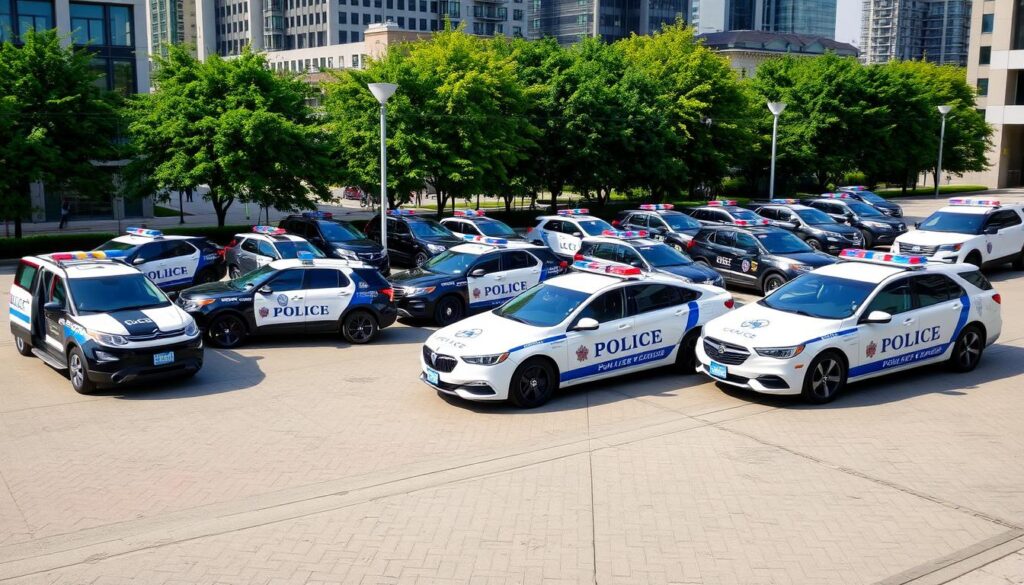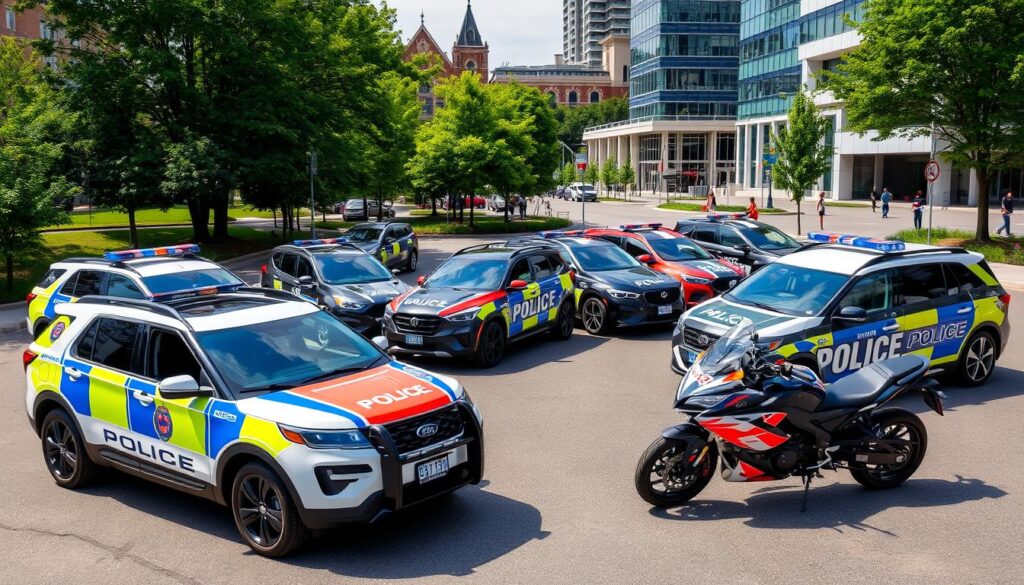Table of Contents
The 2025 Chevrolet Blazer EV Police Pursuit Vehicle is a top choice for police. It’s the only EV made for police work in its class. It has lots of space, 25.5 cubic feet, making it great for police needs.
The Longueuil Agglomeration Police Service won a big award for their vehicles. This shows how important the right cars are for police. The Sohi law Group helps with legal issues related to police vehicles, at 8338779797. They know how key law enforcement vehicles are for safety.
More people want to see police around, a 2023 poll showed. This means police need the best cars. The Ottawa Police Service is getting 50 new Ford Explorers by Canada Day 2025. The 2025 Chevrolet Blazer EV is also a top pick, with a big screen and strong suspension.
Overview of Police Vehicle Needs in Canada
Police cars in Canada, like RCMP cars, need to handle different terrains and weather. They must work well in cities and rural areas, even in harsh weather. The right car is key for police to respond quickly and patrol areas well.
Choosing police vehicles depends on many things. RCMP cars need to fit Canada’s wide range of environments. Canadian police cars also need special features and tech for law enforcement.
Importance of Choosing the Right Vehicle
It’s very important to pick the right police car. The car must do many tasks, like patrolling and emergency responses. It must also meet the needs of each police service.
Factors Influencing Vehicle Selection
Many things affect what police cars are chosen. These include:
- Terrain and climate
- Specific needs of each police service
- Technological requirements
- Budget constraints
Trends in Law Enforcement Vehicle Usage
Law enforcement is moving towards greener and tech-savvy cars. RCMP cars and Canadian police cars are also looking at electric and hybrid options. This is to support their work better.
| Vehicle Type | Features | Benefits |
|---|---|---|
| RCMP cars | 4×4 system, pursuit-rated tires | Enhanced performance and safety |
| Canadian police cars | Advanced communication systems, emergency lighting | Improved response times and officer safety |
Top Police Vehicle Manufacturers in Canada
In Canada, police use many vehicles for their work. Ford, Chevrolet, and Dodge are among the top makers. They offer special features and updates for police needs.
For example, law enforcement agencies get the latest models. These vehicles come with new tech and green options like hybrids and electric cars.
Some top models are Ford’s Police Interceptor Utility, Chevrolet’s Tahoe Police Package, and Dodge’s Durango Pursuit. These cars are built for police work. They have the speed, safety, and tech needed for the job.
Leading Manufacturers’ Contributions
Top makers like Ford have been making police cars for decades. Chevrolet and Dodge also offer models tested for police use. The Chevrolet Lumina and Dodge Charger are examples.
Innovations and Updates
Canada’s top police car makers keep improving their vehicles. They add features like four-wheel-drive and all-wheel-drive. They also make hybrid and electric cars. This shows their focus on new tech and being green.
Popular Police Vehicle Models in 2025
In 2025, several police vehicle models are popular. The Ford Explorer Police Interceptor, Chevrolet Tahoe Police Package, and Dodge Durango Pursuit are favorites. These cars can be fitted with police car accessories and equipment to boost their performance and safety.
The Ford Explorer Police Interceptor is known for its toughness and speed. The Chevrolet Tahoe Police Package has a strong engine and lots of room for gear. The Dodge Durango Pursuit is great for chasing down suspects because of its quickness and agility.
Some key features of these models include:
- Advanced safety features, such as rear-impact crash testing and emergency response systems
- Enhanced performance capabilities, including high-speed pursuit and off-road handling
- Customizable police vehicle equipment, such as communication systems and surveillance technology
These police vehicles are made to meet law enforcement’s needs. They offer a mix of speed, safety, and functionality. By adding the right police car accessories and equipment, agencies can better handle emergencies and protect communities.
| Model | Engine | Top Speed |
|---|---|---|
| Ford Explorer Police Interceptor | 3.3L V6 | 120 mph |
| Chevrolet Tahoe Police Package | 5.3L V8 | 130 mph |
| Dodge Durango Pursuit | 3.6L V6 | 125 mph |
Innovations in Police Vehicle Technology
Technology is changing how police work, with a focus on better communication, green energy, and safety. These advancements are key for police to upgrade their cars and join auctions.
Hybrid and electric cars are becoming popular. They’re good for the planet and save money. For example, Repentigny is testing Quebec’s first electric police car. Bridgewater, N.S., is buying its first electric car, a Tesla Model 3.
Companies like Monerus are making smart police lights with AI and facial recognition. As auctions for police cars grow, it’s vital for police to keep up with new tech. This ensures they can meet today’s policing needs.
| Vehicle Model | Price | Features |
|---|---|---|
| Tesla Model 3 | $52,000 | Electric, all-wheel drive, hatchback design |
| Ford Mustang Mach-E | $50,000 | Electric, all-wheel drive, hatchback design |
Impact of Climate on Vehicle Performance
Canada’s climate is very different, making it hard for law enforcement vehicles. The cold winters and hot summers need vehicles that are tough and easy to keep up. They must also be reliable and not need too much maintenance.
Police cars have to handle all kinds of weather. From the freezing north to the hot south, they need to work well in every climate. This ensures police can do their job safely and efficiently.
Police cars face tough weather like snow, ice, and heat. They need to be durable and easy to maintain. They also need the latest technology to help police do their job better.
Knowing how climate affects vehicle performance helps police choose and care for their cars. This makes them better at keeping communities safe.
Budgeting for Police Vehicle Acquisition
Getting police vehicles in Canada requires careful budgeting. Police departments need to think about the total cost, including the purchase price, maintenance, and fuel. A report by the Community Safety Knowledge Alliance says it’s important to balance the initial cost with long-term expenses.
The RCMP cars show how complex budgeting for police vehicles can be. With rising policing costs and changing crime views, police must find different ways to get the vehicles they need. They can look into government grants, private funding, and leasing options.
- Government grants
- Private funding
- Leasing options
Police departments can also use grants and funding to buy vehicles. For example, the Vancouver Police Foundation raised about $250,000 for a ballistic protected rescue vehicle. By using these options, police can get the vehicles they need without breaking the bank.

| Financing Option | Description |
|---|---|
| Government Grants | Funding provided by the government to support police vehicle acquisition |
| Private Funding | Funding provided by private organizations to support police vehicle acquisition |
| Leasing Options | Options for leasing police vehicles instead of purchasing them outright |
Importance of Vehicle Customization
Canadian police cars and emergency vehicles need special touches to fit their roles. They might get extra gear like lights and comms systems. Branding and markings are key for being seen and recognized.
K9 units get special treatment too. Their vehicles are set up with safe spots for dogs. This shows how customization is vital for police to meet their needs. Key areas for customization include:
- Special equipment needs for different regions
- Branding and markings for visibility
- Enhancements for K9 units
Customizing their vehicles helps Canadian police meet the needs of their areas. It boosts response times, officer safety, and police work overall.
Case Studies from Canadian Provinces
Canadian provinces have shown new ways to manage police fleets and customize vehicles. Ontario works hard to make the most of its police cars. British Columbia has also made big strides in car tech, making police work more efficient.
A study by the Office of the Public Sector Integrity Commissioner shows how key fleet management is for safety. It stresses the need for police to be proactive in managing their vehicles and accessories.
Effective fleet management includes:
- Regular car checks to keep them running well
- Using the right accessories to keep officers safe and efficient
- Creating a detailed plan for each province’s needs

By using these methods, police can make their vehicles and accessories work better. This helps keep everyone safe and saves money.
Training for Officers on New Vehicle Technologies
Training is key for officers to drive police vehicles safely and well. With new police vehicle equipment always coming out, officers must keep up. They need to learn about new tech, how to use it, and stay updated through training.
Officers should know how fast their vehicles can go, how far they can stop, and how much they can carry. They also need to learn about regular car care, like oil changes and tire rotations. Plus, they should know how to take care of their tires, as they are often overlooked.
Police departments can use tools like virtual training and simulation software to help. These tools help officers learn to drive safely and well. Also, police vehicle auctions let departments choose the best vehicles for their needs.
| Training Topic | Frequency | Duration |
|---|---|---|
| Emergency Vehicle Operations | Every 3 years | Multiple hours |
| Vehicle Maintenance | Regularly | Ongoing |
| Simulation Training | As needed | Varying |
By giving officers thorough training and the latest police vehicle equipment, departments can keep them safe. This helps reduce risks in police work and makes the public safer.
Environmental Considerations in Police Vehicles
In Canada, law enforcement is moving towards eco-friendly police vehicles. This change is due to growing environmental worries and the need to cut down on carbon emissions. Using sustainable vehicles helps reduce the environmental impact of police work. It also improves community relations and the image of police services.
Adding eco-friendly vehicles to police fleets is part of a bigger plan to make policing greener. By choosing hybrid or electric cars, police can cut down on greenhouse gas emissions a lot. For example, using technology to stop idling can save a lot of fuel and lower emissions.
The Shift Towards Eco-Friendly Options
Stricter rules on vehicle emissions in Canada also push police towards greener choices. Police are exploring hybrid vehicles to meet these rules and lessen their environmental impact. The savings from using less fuel can also make police work more efficient.
Impact on Community Relations and Image
Using eco-friendly police vehicles can improve how the public sees law enforcement. It shows a commitment to caring for the environment, which many people value. This can build trust and respect between the police and the communities they serve.
Regulations Governing Vehicle Emissions in Canada
Police in Canada must follow rules on vehicle emissions. These rules aim to lessen the environmental harm caused by vehicles, including police cars. By choosing eco-friendly vehicles, police can meet these rules and help keep their communities cleaner and healthier.
Important things to think about when adopting eco-friendly police vehicles include:
– Lower greenhouse gas emissions
– Savings on operating costs from better fuel efficiency
– Better community relations by showing a commitment to the environment
– Meeting stricter vehicle emission rules in Canada
Legal Considerations for Police Vehicles
In Canada, police vehicles face legal hurdles. Liability and insurance are key, ensuring they follow the law and reduce risks. Also, they must meet Canadian vehicle rules to avoid legal and financial trouble.
Understanding Liability and Insurance
Police cars are often in risky situations, leading to accidents or damage. They need good insurance to protect themselves and the public. Knowing liability laws and having the right insurance is key to managing risks.
Compliance with Canadian Regulations
Police cars must follow many Canadian rules on vehicle standards, emissions, and safety. Keeping up with these rules is a big job for police. Not following them can lead to fines, impoundment, or even losing their license.
To stay legal and effective, police in Canada must focus on following the law and managing risks. By doing this, they can keep their communities safe. For more on legal services for businesses, visitSohi Law.





No comment